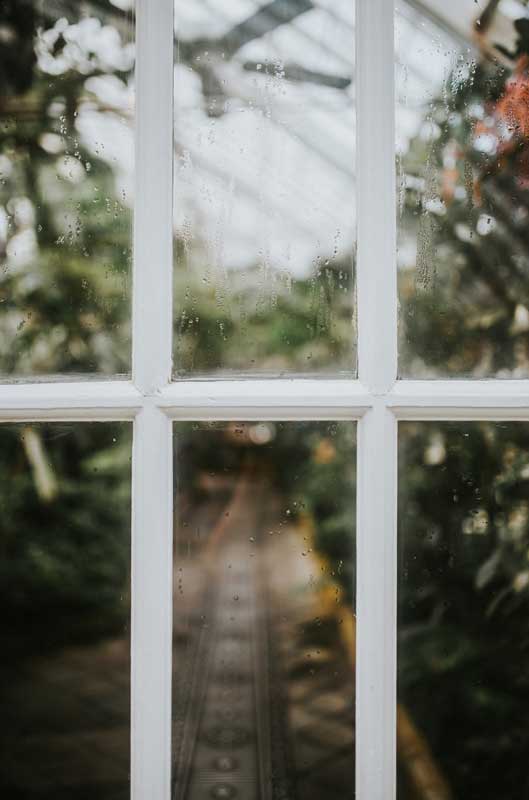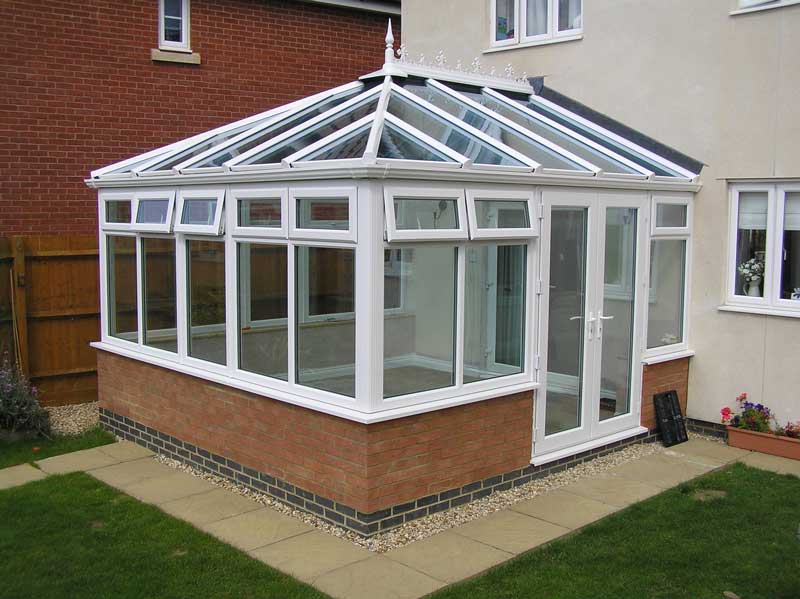You walk into your conservatory on a rainy day, and suddenly you see a leak! Now the water is coming inside and drenching all your belongings. Time to get that conservatory leak fixed as soon as possible and check that insurance policy.
Find out more about what to do if your conservatory is leaking below.
Table of contents
- You’ve noticed your conservatory leaking so what do you do?
- Why do conservatories leak?
- Dealing with conservatory leaks
You’ve noticed your conservatory leaking, so what do you do?
Here’s what you need to do when you realise you have a leaking conservatory.
Step one: Identify the leak!
Common signs of leaks can be more than just visual. You can also identify leaks with your sense of smell.
Additionally, look out for the following:
- Damage to the roof, including the corners and any obvious signs of water damage or deteriorating sections around the roof edges or the glass panes.
- Window frames, windowsills and blinds or curtains can hide damp so check around and behind those areas for discolouration or mould.
- Condensation due to water getting through damaged handles or sealant falling apart. *
- If you cannot spot any leak but are confident there is one, check if your furniture is damp or damaged, as this can be a sign of a leak even if you can’t see it immediately.
- Check where the wall of your property and the conservatory meet, as this can be a common point where leaks can occur.
- Look at where the glass panes have been sealed; ensure there is no deteriorating sealant.
- Take note if there is a musty smell as this can be a sign of dampness and mould caused by water getting to the inside (unless you have purposely put damp clothes or items on a rack in the room to dry prior).
*Note: Windows steaming up can be caused by a lack of good-quality airflow and ventilation, especially in older conservatories. So, check this isn’t the issue before moving forward with a repair.

Step two: Make sure to catch any water leaking into the property with containers
If possible, use a bucket or similar container to catch any of the water leaking through and/or put down towels at areas where water is seeping through, such as windows or doors to help clean up the water leftover from the leaks.
Step three: Contact your local conservatory repair service for support
By contacting a professional, you can have your conservatory inspected as soon as possible. Better yet, the identified issue (if any) can then be dealt with accordingly by professionals as needed so that you’re not umming and ahhing about whether your conservatory needs a repair.
Why do conservatories leak?
If you have a conservatory, leaks are likely to happen for different reasons. Sometimes it can be because the roof is not installed correctly or is damaged. Other times it can be because the guttering is blocked or leaking and not performing as intended. As a result, the leak can encourage mould to grow which is a safety hazard as you’re breathing in spores that can affect your respiratory performance if not treated.
Here are some other issues that can happen if you don’t fix the leak as soon as possible:
- Damage to interior furnishings – You’ll have to spend a hefty amount on repairs, replacements or cleaning.
- Water damage to electricals – This is extremely dangerous and can result in fires if not dealt with quickly.
Your conservatory could also be leaking due to the following reasons:
- Dirt has found its way into the glass.
- The flashing connected between the conservatory and the house isn’t fitting properly.
- The sealant is worn out or damaged between panes.
Common areas where leaks can occur include:
- Roof
- Guttering
- Door
- Walls
- Windows
Modern conservatory roofs are typically made up of panels, frames and vents. With this many connections, these can become faulty over time and are a common source of leaks on a conservatory structure.
However, you might also notice the conservatory roof leaking where it joins the house. This section is usually connected by roof flashing and might need a replacement if damaged.

How much can conservatory roof repairs cost?
Glass conservatory roof replacements can stretch around £4000 to £30,000, whereas a polycarbonate roof replacement can cost anything from £2,000 to £20,000. Glass and polycarbonate are common materials, with Victorian and Edwardian conservatories taking the lead in design.
However, it’s important to know that these prices are not gospel. When speaking to professionals, the cost of a conservatory roof repair will depend on the following:
- The material of the roof.
- The area you are currently living in.
- The age of your property.
- The size of your roof.
- How easy the conservatory is to access.
- Equipment needed to complete the repair.
- The conditions the workers will be in.
- The amount of time the job is going to take.
Can I repair the roof myself?
If you have the necessary skills, absolutely. Just make sure you wait until there is a dry day to work and that the area you’re working on is clean and dry for a more secure repair. Do check with a professional if you are a new DIYer to ensure the task is carried out successfully if you have any concerns.
Having said that, if you are an experienced DIYer there are some cases where you can potentially fix the roof even if that’s just temporarily until you get a professional to make further repairs. This includes dealing with the panels of the roof.
If any panels have slipped or cracked, you can reposition, reseal or replace these to stop the leaks as needed.
You can also prevent leaks caused by your guttering being blocked. Find out how to clean conservatory guttering to ensure your system allows the water to flow freely.
Dealing with conservatory leaks
While the great British weather is often unpredictable, we know one thing for sure:
It’s going to rain. A lot. And if you have a conservatory – especially an older one – chances are, you’re going to get more than a few conservatory leaks during the stormy season.
The good news is:
There’s plenty you can do to stop your conservatory leaking.
As always prevention is better than cure. So, make sure the gutters are clean, the flashing is up to scratch and the sealant is not worn out. And if a leak does occur, identify the source quickly and call the professionals!













